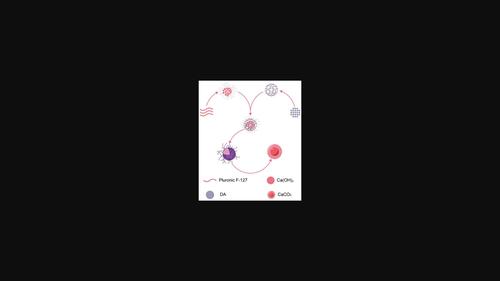Nano-Calcium Carbonate with Core–Shell Structure was Prepared by Dopamine Chelation Using Pluronic F-127 as Template
IF 2.7
4区 材料科学
Q3 CHEMISTRY, PHYSICAL
引用次数: 0
Abstract
Herein, a new template carbonization method is used to prepare calcite-type nano-calcium carbonate (CaCO3) with a core–shell structure using calcium hydroxide as a solute and Pluronic F-127 as a templating and pore-forming agent. Dopamine hydrochloride is added to control the size of calcium hydroxide particles. The morphology, particle size, and crystal type of CaCO3 are characterized via transmission electron microscopy, X-ray diffraction, nanoparticle size, and zeta potentiometer. The creation of core–shell calcium carbonate nanoparticles is examined in relation to reaction circumstances (i.e., additive sequence, additive amount, and additive mixing time), carbonization temperature, liquid flow rate, and templates with varying chain lengths. Furthermore, a discussion is held regarding the formation mechanism of spherical core–shell calcium carbonate that is created using the innovative template carbonization method. The results show that the order, amount, liquid flow rate, and template type of additives have a significant effect on the crystal shape of calcium carbonate nanoparticles. The mixing time of additives has a significant effect on the particle size of calcium carbonate nanoparticles. Interestingly, the thickness of the shell depends on the carbonization temperature, and too slow or too fast flow rate will lead to the formation of cyclic calcium carbonate nanoparticles.

以 Pluronic F-127 为模板,通过多巴胺螯合作用制备具有核壳结构的纳米碳酸钙
本文以氢氧化钙为溶质,Pluronic F-127 为模板和孔隙形成剂,采用新的模板碳化方法制备了具有核壳结构的方解石型纳米碳酸钙(CaCO3)。加入盐酸多巴胺可控制氢氧化钙颗粒的大小。通过透射电子显微镜、X 射线衍射、纳米粒度和 Zeta 电位计对 CaCO3 的形态、粒度和晶体类型进行了表征。研究了核壳碳酸钙纳米粒子的生成与反应环境(即添加剂顺序、添加剂量和添加剂混合时间)、碳化温度、液体流速和不同链长的模板的关系。此外,还讨论了使用创新模板碳化方法生成的球形核壳碳酸钙的形成机理。结果表明,添加剂的顺序、用量、液体流速和模板类型对纳米碳酸钙的晶体形状有显著影响。添加剂的混合时间对纳米碳酸钙颗粒的粒度有显著影响。有趣的是,外壳的厚度取决于碳化温度,流速过慢或过快都会导致形成环状纳米碳酸钙颗粒。
本文章由计算机程序翻译,如有差异,请以英文原文为准。
求助全文
约1分钟内获得全文
求助全文
来源期刊

Particle & Particle Systems Characterization
工程技术-材料科学:表征与测试
CiteScore
5.50
自引率
0.00%
发文量
114
审稿时长
3.0 months
期刊介绍:
Particle & Particle Systems Characterization is an international, peer-reviewed, interdisciplinary journal focusing on all aspects of particle research. The journal joined the Advanced Materials family of journals in 2013. Particle has an impact factor of 4.194 (2018 Journal Impact Factor, Journal Citation Reports (Clarivate Analytics, 2019)).
Topics covered include the synthesis, characterization, and application of particles in a variety of systems and devices.
Particle covers nanotubes, fullerenes, micelles and alloy clusters, organic and inorganic materials, polymers, quantum dots, 2D materials, proteins, and other molecular biological systems.
Particle Systems include those in biomedicine, catalysis, energy-storage materials, environmental science, micro/nano-electromechanical systems, micro/nano-fluidics, molecular electronics, photonics, sensing, and others.
Characterization methods include microscopy, spectroscopy, electrochemical, diffraction, magnetic, and scattering techniques.
 求助内容:
求助内容: 应助结果提醒方式:
应助结果提醒方式:


